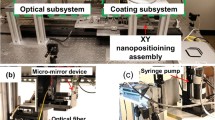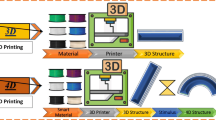Abstract
Additive manufacturing (AM) includes a wide range of technologies that have been specialized to speed up the prototyping, especially in the field of mechanical engineering. In the last years, the use of polymer composites has opened novel opportunities in terms of functionalities to pave the way for a new generation of prototyping. Applications in electronics, medicine, and energy storage are growing and the prototyping of the devices in these fields faces new challenges related to their complexity and functionalities. In parallel, specific resolution capabilities to prototype high-performing devices are needed. For a better understanding of the potentiality and the differences between AM and other manufacturing approaches, a step inside the fundamental principles should be done. One of the main points is the shift from the top-down approach typical of the industry, as, for example, in microelectronics, to a bottom-up approach, which is typical of additive manufacturing and 3D printing. The paradigm change involves first of all the design. The main outcome of the industrial top-down approach is in fact a process flow, while in the AM bottom-up approach, the main outcome is a virtual model. In this scenario, it is of great interest to understand the new approaches introduced not only for the design of the devices, but also the main concepts related to the printability of 3D models and to the post-processing of the final 3D printed object.
Access this chapter
Tax calculation will be finalised at checkout
Purchases are for personal use only
Similar content being viewed by others
References
F42 Committee, ISO/ASTM52900:2021 Additive Manufacturng – General Principles – Terminology. Internet. https://www.iso.org/obp/ui/#iso:std:iso-astm:52900:ed-2:v1:en (2015)
A.E. Alexander et al., A guideline for 3D printing terminology in biomedical research utilizing ISO/ASTM standards. 3D Print. Med. 7, 4–9 (2021)
C. W. Hull, Apparatus for production of three-dimensional objects by stereolithography. Patent 16 (1984)
S. Park, W. Shou, L. Makatura, W. Matusik, K. Fu (Kelvin), 3D printing of polymer composites: Materials, processes, and applications. Matter 5, 43–76 (2022)
M. Criado-Gonzalez, A. Dominguez-Alfaro, N. Lopez-Larrea, N. Alegret, D. Mecerreyes, Additive manufacturing of conducting polymers: Recent advances, challenges, and opportunities. ACS Appl. Polym. Mater. 3, 2865–2883 (2021)
W. Jamróz, J. Szafraniec, M. Kurek, R. Jachowicz, 3D printing in pharmaceutical and medical applications. Pharm. Res. 35, Article 176 (2018)
Z.X. Khoo et al., 3D printing of smart materials: A review on recent progresses in 4D printing. Virtual Phys. Prototyp. 10, 103–122 (2015)
F. Zhang et al., 3D printing technologies for electrochemical energy storage. Nano Energy 40, 418–431 (2017)
L.A. Verhoef, B.W. Budde, C. Chockalingam, B. García Nodar, A.J.M. van Wijk, The effect of additive manufacturing on global energy demand: An assessment using a bottom-up approach. Energy Policy 112, 349–360 (2018)
D.M. Nieto, D.M. Sánchez, Design for additive manufacturing: Tool review and a case study. Appl. Sci. 11, 1–13 (2021)
C. Deckard, Us4863538a (1986)
S. S. Crump, Apparatus and method for creating a three-dimensional object (1989)
E. M. Sachs, J. S. Haggerty, M. J. Cima, P. A. Williams. Three-dimensional printing techniques – United States Patent US5204055 (1993)
S. Maruo, S. Kawata, Two-photon-absorbed photopolymerization for three-dimensional microfabrication, in Proceedings IEEE the Tenth Annual International Workshop on Micro Electro Mechanical Systems. An Investigation of Micro Structures, Sensors, Actuators, Machines and Robots, (IEEE, 1997), pp. 169–174. https://doi.org/10.1109/MEMSYS.1997.581794
https://www.makerbot.com/stories/news/makerbot-reaches-milestone-100000-3d-printers-sold-worldwide/.
https://www.3dsystems.com/blog/foc/apple-acquires-exclusivity-for-freshfiber-iphone-cases.
A. You, M.A.Y. Be, I. In, Development of functional sub-100 nm structures with 3D two-photon polymerization technique and optical methods for characterization. J. Laser Appl. 24, 042004 (2015)
J.R. Tumbleston et al., Continuous liquid interface production of 3D objects. Science (80-. ) 347, 1349–1352 (2015)
H.W. Kang et al., A 3D bioprinting system to produce human-scale tissue constructs with structural integrity. Nat. Biotechnol. 34, 312–319 (2016)
V. Bertana et al., Rapid prototyping of 3D organic electrochemical transistors by composite photocurable resin. Sci. Rep. 10, 1–11 (2020)
H. Wei et al., Direct-write fabrication of 4D active shape-changing structures based on a shape memory polymer and its nanocomposite. ACS Appl. Mater. Interfaces 9, 876–883 (2017)
S. Gantenbein et al., Three-dimensional printing of hierarchical liquid-crystal-polymer structures. Nature 561, 226–230 (2018)
C. Yuan et al., 3D printed reversible shape changing soft actuators assisted by liquid crystal elastomers. Soft Matter 13, 5558–5568 (2017)
J.J. Schwartz, A.J. Boydston, Multimaterial actinic spatial control 3D and 4D printing. Nat. Commun. 10, 791 (2019)
A. Sydney Gladman, E.A. Matsumoto, R.G. Nuzzo, L. Mahadevan, J.A. Lewis, Biomimetic 4D printing. Nat. Mater. 15, 413–418 (2016)
S. Tibbits, 4D printing: Multi-material shape change. Archit. Des. 84, 116–121 (2014)
R. Doering, Y. Nishi, Handbook of Semiconductor Manufacturing Technology – 2nd Edition. Microelectronics Journal, vol 32 (CRC Press Taylor/Francis Grouo, 2001)
S.A. Rizvi, Handbook of Photomask Manufacturing Technology (Taylor & Francis, New York, 2005). https://doi.org/10.1201/9781420028782
V. Pavlidis, S. Ioannis, E. Friedman, Three-Dimensional Integrated Circuit Design – 2nd Edition (Morgan Kaufmann, 2017)
N.A. Sherwani, Via minimization and over-the-cell routing, in Algorithms for VLSI Physical Design Automation, (Springer US, 1993), pp. 323–353. https://doi.org/10.1007/978-1-4757-2219-2_8
A. Holovatyy, V. Teslyuk, M. Lobur, M. Szermer, C. Maj, Mask layout design of single- and double-arm electrothermal microactuators, in 2016 XII International Conference on Perspective Technologies and Methods in MEMS Design (MEMSTECH), (IEEE, 2016), pp. 28–30. https://doi.org/10.1109/MEMSTECH.2016.7507513
M. Afshar et al., On-chip nanostructuring and impedance trimming of transparent and flexible ITO electrodes by laser induced coherent sub-20 nm cuts. Appl. Surf. Sci. 360, 494–501 (2016)
A. Tommasi et al., Modeling, fabrication and testing of a customizable micromachined hotplate for sensor applications. Sensors 17, 62 (2016)
N. Wilke, A. Mulcahy, S.-R. Ye, A. Morrissey, Process optimization and characterization of silicon microneedles fabricated by wet etch technology. Microelectron. J. 36, 650–656 (2005)
P.A. Alvi, International Frequency Sensor Association, MEMS Pressure Sensors: Fabrication and Process Optimization (International Frequency Sensor Association Publishing, 2012)
D.S. Macintyre et al., Nanoimprint lithography process optimization for the fabrication of high electron mobility transistors. J. Vac. Sci. Technol. B Microelectron. Nanom. Struct. 21, 2783 (2003)
O. Pilloni, M. Madou, D. Mendoza, S. Muhl, L. Oropeza-Ramos, Methodology and fabrication of adherent and crack-free SU-8 photoresist-derived carbon MEMS on fused silica transparent substrates. J. Micromech. Microeng. 29, 027002 (2019)
R. Natu, M. Islam, J. Gilmore, R. Martinez-Duarte, Shrinkage of SU-8 microstructures during carbonization. J. Anal. Appl. Pyrolysis 131, 17–27 (2018)
M.C. Prado, D. Jariwala, T.J. Marks, M.C. Hersam, Optimization of graphene dry etching conditions via combined microscopic and spectroscopic analysis. Appl. Phys. Lett. 102, 193111 (2013)
A. Ballesio et al., A novel hot embossing graphene transfer process for flexible electronics. Microelectron. Eng. 209, 16–19 (2018)
A.L. Rickard, M.E. McNie, in Characterization and Optimization of Deep Dry Etching for MEMS Applications, ed. by U. F. W. Behringer, D. G. Uttamchandani, (2001), pp. 78–88. https://doi.org/10.1117/12.425287
N.N. Alias, K.A. Yaacob, S.N. Yusoh, A.M. Abdullah, Comparison of KOH and TMAH etching on Sinw arrays fabricated via AFM lithography. J. Phys. Conf. Ser. 1082, 012051 (2018)
S.J. Fonash, ChemInform abstract: An overview of dry etching damage and contamination effects. ChemInform 22(21), 310 (2010)
A. Tommasi et al., Process optimisation of a MEMS based PZT actuated microswitch. Microelectron. Eng. 119, 137–140 (2014)
J. Micallef, Beginning Design for 3D Printing (Apress, Berkeley, 2015). https://doi.org/10.1007/978-1-4842-0946-2
N. van de Werken et al., Design considerations and modeling of fiber reinforced 3D printed parts. Compos. Part B Eng. 160, 684–692 (2019)
S. Mckee et al., Microfabrication of polymer microneedle arrays using two-photon polymerization. J. Photochem. Photobiol. B Biol. 229, 112424 (2022)
V. Bertana et al., 3D printing with the commercial UV-curable standard blend resin: Optimized process parameters towards the fabrication of tiny functional parts. Polymers (Basel). 11, 292 (2019)
G. Scordo et al., A novel highly electrically conductive composite resin for stereolithography. Mater. Today Commun. 19, 12–17 (2019)
F. Barbaresco, M. Cocuzza, C.F. Pirri, S.L. Marasso, Application of a micro free-flow electrophoresis 3D printed lab-on-a-chip for micro-nanoparticles analysis. Nano 10, 1277 (2020)
F. Perrucci et al., Optimization of a suspended two photon polymerized microfluidic filtration system. Microelectron. Eng. 195, 95–100 (2018)
A. Massaccesi et al., Broadband dielectric transmitarray with scanning capabilities, in 13th European Conference on Antennas and Propagation, EuCAP 2019, (2019), pp. 11–12
M.K. Thompson et al., Design for additive manufacturing: Trends, opportunities, considerations, and constraints. CIRP Ann. – Manuf. Technol. 65, 737–760 (2016)
N. Meisel, C. Williams, An investigation of key design for additive manufacturing constraints in multimaterial three-dimensional printing. J. Mech. Des. 137, 111406 (2015)
Author information
Authors and Affiliations
Corresponding author
Editor information
Editors and Affiliations
Rights and permissions
Copyright information
© 2022 The Author(s), under exclusive license to Springer Nature Switzerland AG
About this chapter
Cite this chapter
Parmeggiani, M., Ballesio, A., Cocuzza, M., Marasso, S.L. (2022). Introduction to High-Resolution Manufacturing from 2D to 3D/4D Printing Technology Evolutions and Design Considerations. In: Marasso, S.L., Cocuzza, M. (eds) High Resolution Manufacturing from 2D to 3D/4D Printing. Springer, Cham. https://doi.org/10.1007/978-3-031-13779-2_1
Download citation
DOI: https://doi.org/10.1007/978-3-031-13779-2_1
Published:
Publisher Name: Springer, Cham
Print ISBN: 978-3-031-13778-5
Online ISBN: 978-3-031-13779-2
eBook Packages: Biomedical and Life SciencesBiomedical and Life Sciences (R0)




